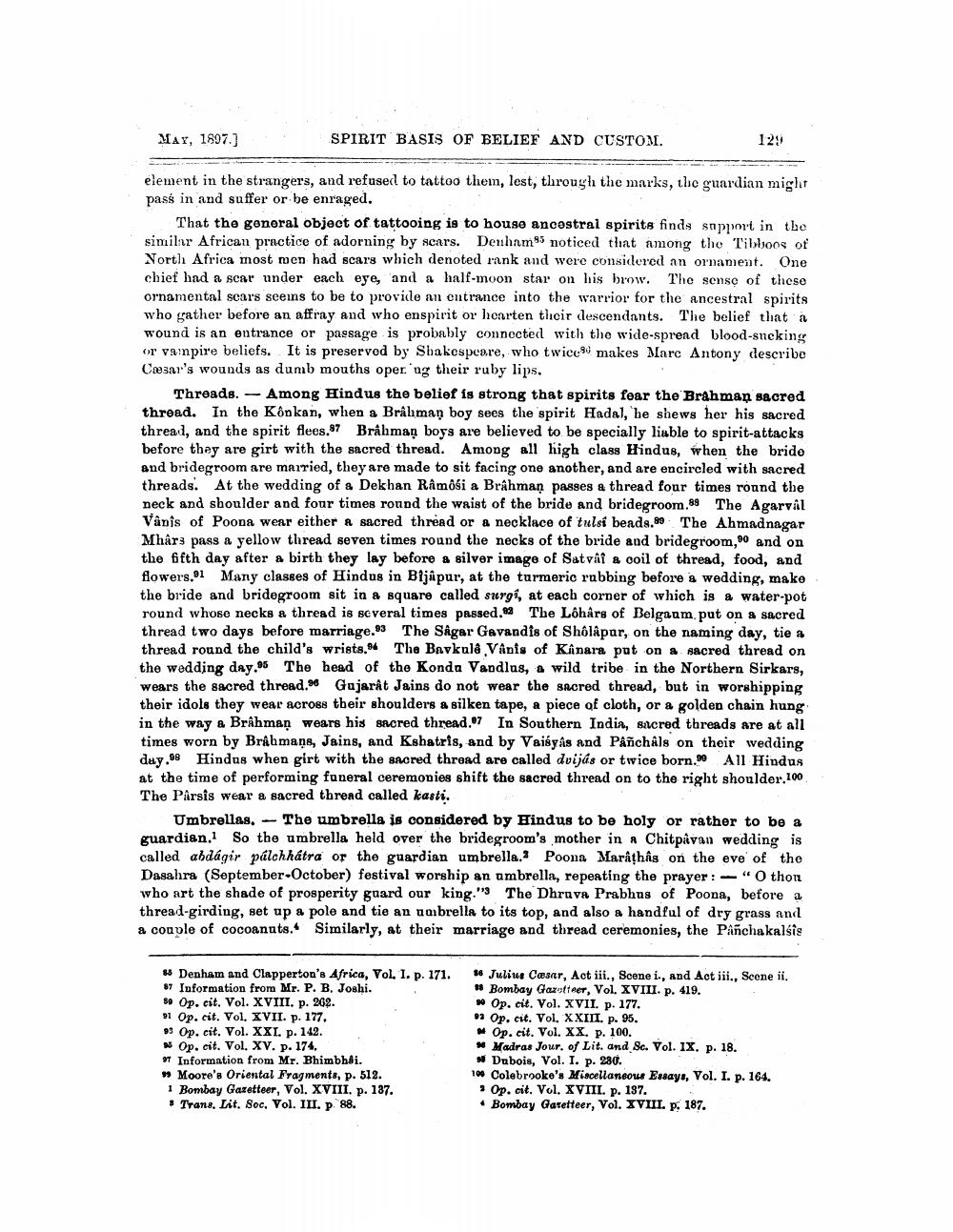________________
MAY, 1897.)
SPIRIT BASIS OF BELIEF AND CUSTOM.
129
element in the strangers, and refused to tattoo them, lest, through the marks, the guardian might pass in and suffer or be enraged.
That the goneral object of tattooing is to house ancostral spirits finds support in the similar African practice of adorning by scars. Denham' noticed that among the Tilboos of North Africa most men had scars which denoted rank and were considered an ornament. One chief had a scar under each eye, and a half-moon star on his brow. The sense of these ornamental scars seems to be to provide an entrance into the warrior for the ancestral spirits who gather before an affray and who enspirit or hearten their descendants. The belief that a wound is an entrance or passage is probably connected with the wide-sprend blood-sucking or vanpire beliefs. It is preserved by Shakespeare, who twice makes Marc Antony describe Conr's wounds as dumb mouths oper'ng their ruby lips.
Threads. - Among Hindus the belief is strong that spirits fear the Brahman sacred thread. In the Kônkan, when a Brahman boy sees the spirit Hadal, he shews her his sacred thread, and the spirit fees.97 Brâhman boys are believed to be specially liable to spirit-attacks before they are girt with the sacred thread. Among all high class Hindus, when the bride and bridegroom are mairied, they are made to sit facing one another, and are encircled with sacred threads. At the wedding of a Dekhan Ramosi a Brahman passes a thread four times round the neck and shoulder and four times round the waist of the bride and bridegroom.89 The Agarval Vânîs of Poona wear either a sacred thread or a necklace of tulsi beads.89 The Ahmadnagar Mhårs pass a yellow thread seven times round the necks of the bride and bridegroom, and on the fifth day after a birth they lay before a silver image of Satvat a coil of thread, food, and flowers.91 Many classes of Hindus in Bljâpur, at the turmeric rubbing before a wedding, make the bride and bridegroom sit in a square called surgi, at each corner of which is a water-pot round whose necks a thread is several times passed. The Lôhårs of Belgaum, put on a sacred thread two days before marriage. The Sågar Gavandis of Sholápar, on the naming day, tie a thread round the child's wrists. The Bavkule Vanis of Kinara put on a sacred thread on the wedding day. The head of the Konda Vandlus, & wild tribe in the Northern Sirkars, wears the sacred thread. Gujarat Jains do not wear the sacred thread, but in worshipping their idols they wear across their shoulders a silken tape, a piece of cloth, or a golden chain hung in the way a Brahman wears his sacred thread.07 In Southern India, sacred threads are at all times worn by Brahmans, Jains, and Kshatris, and by Vaisyâs and Pañchals on their wedding day.98 Hindus when girt with the sacred thread are called dvijás or twice born. All Hindus at the time of performing funeral ceremonies shift the sacred thread on to the right shoulder 100 The Parsis wear a sacred thread called kasti.
Umbrellas. - The umbrella is considered by Hindus to be holy or rather to be a guardian. So the umbrella held over the bridegroom's mother in a Chitpavan wedding is called abdágir pálchhátra or the guardian umbrella. Poona Markthâs on the eve of the Dasahra (September October) festival worship an umbrella, repeating the prayer :-"Othon who art the shade of prosperity guard our king." The Dhruva Prabhus of Poona, before a thread-girding, set up a pole and tie an umbrella to its top, and also a handful of dry grass and a couple of cocoanats. Similarly, at their marriage and thread ceremonies, the Panchakalsis
35 Denham and Clapperton's Africa, Vol. 1. p. 171. 87 Information from Mr. P. B. Joshi. 89 Op. cit, Vol. XVIII. p. 262. 91 Op. cit. Vol. XVII. p. 177. 95 Op. cit. Vol. XXI. p. 142.
Op.cit. Vol. XV. p. 174, 97 Information from Mr. Bhimbhdi. » Moore's Oriental Fragments, p. 512. 1 Bombay Gazetteer, Vol. XVIII. p. 137. * Trans. Lit. Soc, Vol. III. p. 88.
16 Julius Cæsar, Act iii., Scene i., and Act iii., Scene ii. # Bombay Gazotteet, Vol. XVIII. p. 419. * Op. cit. Vol. XVII. p. 177. 93 Op. cit. Vol. XXIII. p. 95.
Op. cit. Vol. XX. p. 100. * Madras Jour, of Lit. and Sc. Vol. IX. p. 18.
Dubois, Vol. I. p. 280. 100 Colebrooke's Miscellaneous Essays, Vol. I. p. 164.
• Op. cit. Vol. XVIII. p. 137. • Bombay Garetteer, Vol. XVIII. p. 187.




